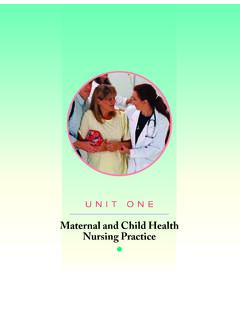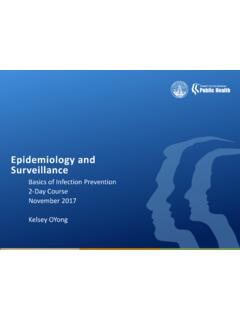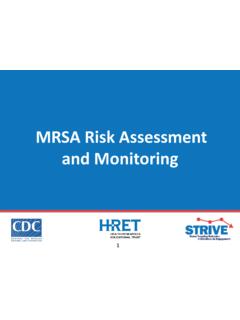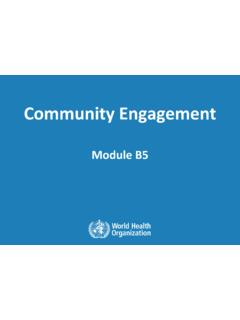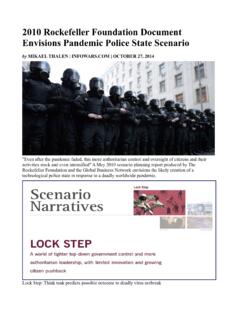Transcription of WHO 2019 nCoV HCF Operations - World Health Organization
1 1 Operational considerations for case management of COVID-19 in Health facility and community Interim guidance 19 March 2020 Background This document is intended for Health ministers, Health system administrators, and other decision-makers. It is meant to guide the care of COVID-19 patients as the response capacity of Health systems is challenged; to ensure that COVID-19 patients can access life-saving treatment, without compromising public Health objectives and safety of Health workers. It promotes two key messages: 1. Key public Health interventions regardless of transmission scenario; and 2. Key action steps to be taken by transmission scenario to enable timely surge of clinical Operations . The public Health objectives at all stages of the preparedness and response plan are to: Prevent outbreaks, delay spread, slow and stop transmission.
2 Provide optimized care for all patients, especially the seriously ill. Minimize the impact of the epidemic on Health systems, social services, and economic activity. Based on the largest cohort of COVID-19 patients, about 40% of patients with COVID-19 may have mild disease, where treatment is mostly symptomatic and does not require inpatient care; about 40% of patients have moderate disease that may require inpatient care; 15% of patients will have severe disease that requires oxygen therapy or other inpatient interventions; and about 5% have critical disease that requires mechanical However, the evolution of the outbreak in some countries has shown a higher proportion of severe and critical cases and the need to rapidly increase surge capacity to prevent rapid exhaustion of biomedical supplies and staff. In some countries, doubling rates of cases every 3 days has been scenarios of transmission Countries or subnational areas will have to respond rapidly to one or more epidemiological scenarios .
3 Currently, four transmission scenarios are observed:3 1. Countries with no cases (no cases); 2. Countries with one or more cases, imported or locally acquired (sporadic cases); 3. Countries experiencing cases clusters in time, geographic location, or common exposure (clusters of cases); 4. Countries experiencing larger outbreaks of local transmission (community transmission). Countries will experience one or more of these situations at the subnational level and must tailor their approach to the local context. For clinical care, six major interventions must be put into place immediately, and then scaled up according to epidemiologic scenarios (see Table 3). Operational considerations for case management of COVID-19 in Health facility and community: interim guidance 2 The document is organized to guide key actions by transmission scenario to enable timely surge of clinical Operations .
4 Scenario and strategic priorities Table 1. Key recommendations based on case severity and risk factors, irrespective of transmission scenario Case severity, risk factorsa Recommendations Mild Moderate, with no risk factors Patient should be instructed to self-isolate and contact COVID-19 information line for advice on testing and referral. Test suspected COVID-19 cases according to diagnostic strategy. Isolation/ cohorting in: Health facilities, if resources allow; Community facilities ( stadiums, gymnasiums, hotels) with access to rapid Health advice ( adjacent COVID-19 designated Health post/EMT-type 1, telemedicine)4; Self-isolation at home according to WHO guidance. Moderate, with risk factors Severe Critical Patient should be instructed to self-isolate and call COVID-19 hotline for emergency referral as soon as possible. Hospitalization for isolation (or cohorting) and inpatient treatment.
5 Test suspect COVID-19 cases according to diagnostic strategy. a Known risk factors for severe COVID-19: age over 60 years, hypertension, diabetes, cardiovascular disease, chronic respiratory disease, immunocompromising conditions. Note: Probable cases should be retested immediately. CriticalSevereModerateMildMechanical ventilationOxygen therapyIsolationSeverity of disease Resource requirements Operational considerations for case management of COVID-19 in Health facility and community: interim guidance 3 Table 2. Summary of strategic priorities by scenario Scenario Priorities No cases 1. Set up screening and triage protocols at all points of access to the Health system, including primary Health centres, clinics, hospital emergency units, and ad hoc community settings. 2. Set up COVID-19 telephone hotline and referral system to refer patients to the appropriate destination for clinical assessment and/or testing as per local protocol.
6 3. Set up COVID-19 designated wards in Health facilities. 4. Conduct active case finding, contact tracing and monitoring, quarantine of contacts, and isolation of suspected cases. 5. Prepare for next scenario. Sporadic cases 1. Screen and triage at all points of access to the Health system, including primary Health centres, clinics, hospital emergency units, and ad hoc community settings. 2. Care for all suspected and confirmed COVID-19 patients in isolation (or cohorting) according to disease severity and acute care needs for treatment at the COVID-19 designated treatment area (Table 1). 3. Continue rapid and thorough contact tracing and quarantine of contacts. 4. Prepare for next scenario. Clusters of cases 1. Screen and triage at all points of access to the Health system, including primary Health centres, clinics, hospital emergency units, and ad hoc community settings.
7 2. Care for all COVID-19 patients in the designated treatment area, according to disease severity and acute care needs according to the recommendations in Table 1. 3. Surge by repurposing wards or ICUs into COVID-19 wards and hospitals. 4. Where Health facilities can no longer manage patients with mild or moderate disease, isolate patients who are not at high risk for severe disease (< 60 years of age, no co-morbid diseases) either in community facilities ( stadium, gymnasium, hotel, or tent) with access to rapid Health advice ( via adjacent dedicated COVID-19 Health post, telemedicine) or at home according to WHO If patient develops symptoms that may correspond to complications, ensure rapid referral to hospital. 5. Plan for new structures to augment the Health system based on the assumption that the number of cases will double every 3 to 7 days subject to the effectiveness of public Health interventions.
8 Community transmission 1. Screen and triage at all points of access to the Health system, including primary Health centres, clinics, hospital emergency units, and ad hoc community settings. 2. Care for all suspected and confirmed COVID-19 patients in the designated treatment area, according to disease severity and acute care needs according to the recommendations in Table 1. 3. Surge the Health system with new structures established for care delivery, including rapid extension of designated hospitals to care for COVID-19 patients. 4. New hospitals or temporary structures can serve to augment COVID-19 patient care or essential Health services, depending on national strategy. 5. Referrals adopt a hub and spoke model, with a central COVID-19 referral facility and all other Health facilities in each geographical area referring patients to the nearest centre (see referral pathway b).
9 6. Manage all mild and low- to moderate risk patients with confirmed disease in designated community facilities ( stadium, gymnasium, hotel or tent) with access to rapid Health advice ( via adjacent dedicated COVID-19 Health post, telemedicine) or at home according to WHO guidance and national or subnational If patient develops symptoms that may correspond to severe disease or complications, ensure rapid referral to hospital. 7. Depending on testing strategy and capacity, mild and moderate patients may not be tested, and advised to self-isolate either in cohorted community facilities or at home. Operational considerations for case management of COVID-19 in Health facility and community: interim guidance 4 Immediate public Health interventions Table 3. Summary of immediate public Health interventions, irrespective of transmission scenario Community messaging Messages should include the following: 1.
10 COVID-19 symptoms: distinction between mild symptoms versus severe symptoms. Mild patients should be isolated to reduce transmission and told to self-isolate at home and call COVID informational line for advice on testing and referral. Mild and moderate patients may be isolated either in Health facility, community facilities ( stadium, gymnasium, hotel or tent) with access to rapid Health advice ( adjacent COVID-19 dedicated Health post/EMT-type 1, telemedicine) or self-isolate at home. Severely ill patients should call COVID hotline to seek emergency referral to Health facility. 2. Engage everyone in hand washing, respiratory hygiene, and physical distancing. 3. Access local 24/7 COVID-19 telephone hotline or designated number that patients can call for information and direction about when and where they should seek care.











